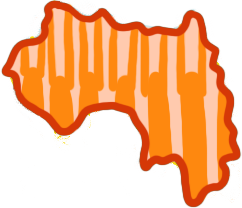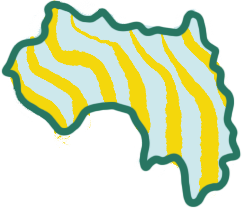Text
Earlier, I covered how to use verbs in the "present", or what linguists call the "imperfective." This means that you already know how to say things like "I go" or "We study Maninka."
But what happens if we want to say "I went" or "We studied Maninka"? In these cases, we need to learn how to use verbs in the "past tense" or what linguists call the "perfective aspect."
In this chapter, I'll cover the following:
- a reminder of how to make sentences with verbs
- The "simple" past
- The "recent" past
- a recap of Maninka verbs in the "past" and "present"
Reminder of verbal structure
Remember from earlier that sentences with verbs have a structure like the following:
N ye wala.
I + PRESENT + go-PRESENT'I go' / 'I am going'
Or:
N di wa.
I + FUTURE/HABITUAL.PRESENT + go'I (will) go.'
Or, if we wanted to make things negative and have a sentence with a direct object, we could say something like
An tɛ maninkakan mɛnna.
we + PRESENT.NEG + Maninka + understand-PRESENT'We don't understand Maninka.'
Or:
I tɛ foyi kɛ
you PRESENT.NEG nothing do"You don't do nothing"
(as in, "You don't do anything")
So underlyingly, we have a structure like this:
SUBJECT+PREDICATE MARKER+ (DIRECT OBJECT) +VERB
Remember that predicate marker is just the fancy linguistic term for the auxiliaries (AUX) or "helper words", ye and tɛ, that allows us to use a particular verb in the "present."
Let's keep this structure in mind; it will mostly hold for verbal sentences. Though, as you'll see, there is one major exception.
The "Simple" Past
Maninka has two basic ways of expressing the idea of the past tense. The first one is formally known by linguists as the "perfective". But, for our purposes, I will call it the "simple past".
It is formed in two different ways depending on whether a sentence is transitive or intransitive.
Transitively with kà
Taking a transitive sentence—that is, one with a direct object—and putting it into the past is very straightforward.
For instance, we can take a sentence like the following:
N ye cɛkɔrɔba fola.
I AUX elder.man greet'I greet the elder man'
To make it "perfective", we need to do two things. First, we change ye to its past equivalent kà. Second, we drop the suffix -la from the the verb. Like so:
N kà cɛkɔrɔba fo.
'I greeted the elder man.'
(or, 'I have greeted the elder man.')
(NOTE: I am marking the low tone on kà, but you’ll often see it written without a tone. I have done so because there is another predicate marker ká with a high-tone that is used for "Imperatives", which you will learn about later.)
Conveniently, this "past tense" using kà and all the forms that follow in this chapter cover two things: what English grammarians call the past (e.g., "I greeted the man") and the present perfect (e.g., "I have greeted the man").
There is no need to make this distinction when speaking in Maninka! The context will make the meaning clear.
In the case of negative sentences, the underlying process is the same. For example, take a sentence like:
Àlu tɛ faransikan karan.
'They don't study French.'
(Note that
karancan also mean 'to read'.)
To make it negative, we simply change the predicate marker tɛ to it past equivalent ma:
Àlu ma faransikan karan.
'They didn't study French.'
(or, 'They haven't studied French.)
Also, note that this verbal negative predicate marker ma looks like the negative predicate marker man that is used with qualitative verbs, but they are not the same. The former is written without n and the latter with n. You can see the difference in an example like this:
I ma maninkakan karan. O man ɲi.
'You didn't study Maninka. That's not good.'
Intransitively with -da
When it comes to intransitive verbs and sentences, things will get slightly more complicated. This is because there is an exception to the SUJ + AUX + (object) + VERB structure that I laid out earlier.
For starters, let's take a future/habitual intransitive sentence like the following:
N di wa.
I AUX go"I go / I will go"
To make this sentence "perfective" (that is, to put it into the "simple past"), we do something quite different. Instead of changing the predicate marker di (or ye ... -la in a sentence like N ye wala), we actually drop it from the sentence and instead add the perfective suffix -da to the verb:
N wada.
'I went/left.'
(or, 'I have gone/left.')
Notice how there is no predicate marker between the subject and the verb. This is an exception to the general pattern of how verbs are "conjugated" in Maninka (and Manding in general).
Let's look at another example so that things are clear. We'll start with a "present tense" sentence like:
Àlu ye bɔla.
they PRESENT exit-PRESENT'They exit.'
(Or, 'They go out.')
To make it perfective, it changes like so:
Àlu bɔda.
'They exited.'
(Or, 'They went out.')
The -da exception does not apply to negative intransitive constructions; we follow the regular verbal sentence structure of SUJ + AUX + VERB. For instance, let's take a negative intransitive sentence in the "present" such as:
N tɛ wala.
I PRESENT.NEG go-PRESENT'I am not going.'
If we want to put this sentence into the "past" then we follow the same procedure that we did earlier with transitive constructions; tɛ will be switched to its perfective equivalent ma and there's no need for the suffix -la on the verb:
N ma wa.
'I didn't go.'
But remember! If we want to make it positive, there is no predicate marker between the subject and verb — just the suffix -da on the verb:
N wada
'I went'
On that note, let me add one last thing about -da as the simple past marker.
By convention, I write it-da, but you may hear it pronounced or written -ra. For instance:
Àlu bɔra
'They exited'
(NOTE: I have chosen the convention of -da because it lines up with the written convention that N'ko orthography generally uses.)
Moreover, when -da/ra follows a nasalized vowel, it can also pronounced -na. For instance:
N di na → N nana
'I (will) come' → 'I came'
If you run into some variability, don't get thrown off. You may hear one person say N nada or N nara while another says N nana for 'I have come' (as in, 'I have arrived'). Personal and regional differences such as these are similar to the way that some Americans say "roof" and others "ruff" for the thing on top of a house.
What's important for you is to know that underlyingly -da is one suffix that signals the "simple past tense" for an intransitive verb. So get comfortable recognizing and using it!
The "Recent" Past (with bada)
The second way that the past is marked on verbs in Maninka is formally known as the "perfect". In short, it is generally used when a past event has current relevance to the situation at hand.
Practically speaking for language learners, such a distinction is hard to parse. As such, most speakers of English, French and other Western languages often find it easier to simply think of it as the "recent past". For convenience's sake, I will use that term.
The recent past follows the pattern that you are used to. It is formed by simply using the predicate marker bada (which you may also encounter pronounced or written as bara).
For example, transitively:
Sita bada Madu fo
Sita RECENT.PAST Madu greet'Sita greeted Madu' / 'Sita has greeted Madu'
The negative form is the same as that which you learned for the simple past marker kà:
Sita ma Madu fo
'Sita did not greet Madu' / "Sita hasn't greeted Madu"
So, in the negative, there is no way to distinguish the "simple past" from the "recent past". You should be happy! One less distinction to master.
The particulality of bada as compared to kà is that it can also be used intransitively (like you are used to for other predicate markers such as ye, di and tɛ). For example:
Adama bada wa
Adama RECENT.PAST go'Adama went/left'
Note that the "simple past" equivalent of this sentence would be like this:
Adama wada Adama go-SIMPLE.PAST
'Adama went/left'
Recap
Now that I've walked us through all the different forms related to verbs in the "past", let's do a general take-away about using verbs in the past and present.
The verbal structure of a Maninka (and, in general, Manding) sentence is as follows:
SUBJECT + AUX + (OBJECT) + VERB
Depending on how you want to use a verb—in the "present" (imperfective), the "past" (perfective), positively, or negative—you will change the auxiliary (AUX) or "predicate marker" (e.g., ye, di, tɛ, kà, ma) that appears following the subject.
The exception to this is intransitive verbs when used positively in the "past", where instead of an auxiliary, we attach a suffix (-da) to the verb.
You can visualize this dynamic in a table like this:
| SUBJECT | AUX | (OBJECT) | VERB | |
|---|---|---|---|---|
| Present | ye/tɛ |
-la |
||
| Habitual / Future | di/tɛ |
|||
| Simple Past - trans. | kà/ma |
|||
| Simple Past - intrans. pos. | -da |
|||
| Simple Past - intrans. neg. | ma |
|||
| Recent Past | bada/ma |
Summary
Ayiwa! We covered the following in this chapter:
-
The simple past is formed with the predicate marker
kàtransitively:N kà ji min
'I drank water' -
The simple past is formed with the suffix
-daintransitivelyN bɔda
'I went out' -
The recent past is formed with
badatransitively and intransitively:N bada ji min
'I drank water'N bada bɔ
'I went out' -
The negative of the simple and the recent past is formed with
maboth transitively and intransitively:N ma ji min
'I didn't drink water'N ma bɔ
'I didn't go'
Vocab
Coming soon n'Ala sɔnna!
- bada
- transitive "recent" past marker
- ka
- transitive past marker
- -da [-ra/la/na]
- intransitive affirmative past marker
- ma
- negative past marker
- N wada
- I went; I left
- N bada wa
- I went; I left (recently)
- N ma wa
- I didn't go
- N kà i fo [N k'i fo]
- I greeted you
- N bada i fo
- I greeted you (recently)
- N ma i fo [N m'i fo]
- I didn't greet you
- I bada à ye?
- Did you see it (recently)?
- I kà à ye? [I k'à ye?]
- Did you see it?
- I m'à ye?
- Did you not see it?
- faransikan
- French language (lit. 'France language')
- k'à lɔn
- to know something/someone
- ka sunɔɔ
- to sleep
- ka mɛɛn
- to last; to occur a while back
- ka mɛɛn yan
- to be here for a longtime
- ka mɔɔ deyi (fen na)
- to teach someone ([about] something)
- ka fen deyi
- to learn something
- kolo
- bone
Vocab list will be here someday!
Flashcards will be here someday!
Exercises
Exercises will be here someday!




